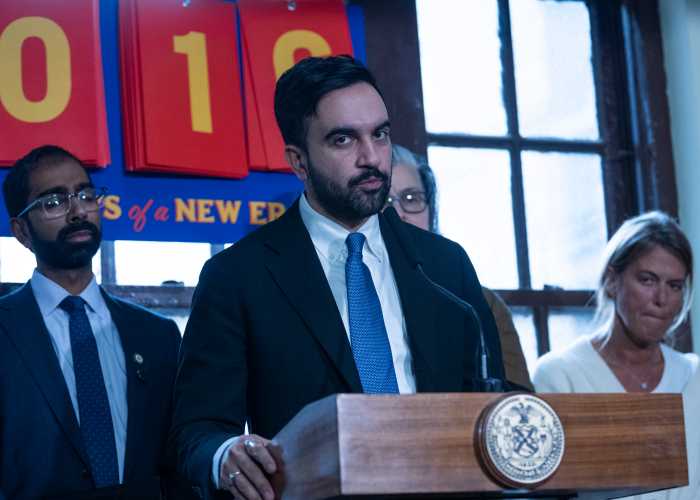Natasha Johnson waited patiently in the packed foyer at Elohim Christian Church in Richmond Hill for her number to be called. She was there on Monday night with her four-year-old daughter Emani to pick up frozen meat, bags of canned pasta, peas, cranberry sauce and other foodstuffs from the churchs food bank.
"Its allowing me to save money and provide for my daughter," said Johnson, who lost her job in the airline industry after September 11.
Across the room, 59-year-old Steve, who declined to give his last name, stood near the line of people that wound its way from the church doors through a back hallway to a side exit. The former shipping manager for an import/export company was laid off after the terror attacks and still hasnt found work.
Asked how he felt on his second visit to the food bank, he replied, "At one time it wouldve felt a lot worse, but Im accepting it."
Natasha, Emani and Steve are just three of about 130,000 Queens residents who depend on the boroughs 174 soup kitchens and food pantries to keep their cupboards stocked and stomachs full. In the last two years, the number of people using emergency food programs in Queens has jumped 146%the biggest increase of all five boroughs, according to the latest survey by the New York City Coalition Against Hunger (NYCCAH).
And while the Bronx, Brooklyn and Manhattan serve more people, Queens saw the largest increase in the number of feeding agencies, gaining nearly two dozen in 2001-2002.
NYCCAH and another group, the Hunger Action Network of New York State (HANNYS), blamed the sharp increase in demand citywide for emergency food supplies on the lingering economic fallout of September 11.
"Queens has been disproportionately hurt with problems in the airline industry," said Joel Berg, executive director of NYCCAH, who noted that 50% of the airline industry jobs lost since September 11 have not come back.
Berg added that immigration into Queens has brought "new populations in need of help," which have in turn spurred the creation of new food programs that spiked the count of hungry people in the survey.
"Statistically, the most significant thing is that there was a dramatic increase everywhere," he said.
Pat Wade, executive director of the Ridgewood Older Adult Center, reported an increase in the number of formerly middle-class people using the centers food pantry.
"Were getting chronically poor and needy people, but were also getting people who are out of work and whose unemployment benefits have run out. Its a surprise situation for them," she said.
The centers program, which is sponsored by the Ridgewood Presbyterian Church, distributes between 250-300 bags of food per month, with each bag containing enough packaged food for six meals.
Supply And Demand
Most alarming, advocates say, is that lower donations this year have forced agencies to turn away nearly 350,000 New Yorkers in search of food, many of them children and elderlyand that 17% of Queens feeding agencies cannot feed everyone who comes to them.
Anthony Miranda, who runs the food pantry at Elohim Christian Church, had to close for two days in August because there was not enough food.
An anonymous donation of $20,000 has allowed the program, which feeds about 9,000 people a month, to stay afloat.
Long lines forced Miranda to open an additional day so that elderly patrons would not have to wait in the cold.
"Its a terrible problem," said Miranda, who says his caseload has nearly quadrupled in the last year. "The amount of rent [people] pay, the only place they can cut back is the table."
Mirandas program was lucky to get a large donation. Potential donors "are themselves going through tough economic times," said Susannah Pasquantonio, community food coordinator for HANNYS.
Pasquantonios group found that Queens food programs cash donations have dropped by half in the last year, and fears additional cuts to food programs by the city and Albany, both of which face looming budget deficits.
Root Causes
In its report, NYCCAH cited additional factors such as a low minimum wage and logistical barriers placed by the citys Human Resources Administration (HRA) in applying for federal food stamps, such as 16-page applications and inconvenient office hours, in the skyrocketing demand at local food pantries.
HRA spokesman Carl Strange said that his agencys outreach efforts had increased food stamp participation by 17% among people who dont already receive public assistance.
"We are all in favor of reducing the size of the application, but that is something that the state determines," added Strange.
For their part, Elohim Church and the Ridgewood Older Adult Center have tried to reduce patrons dependency on the food pantry by helping them apply for food stamps.
Elohims Miranda even made a deal with the Board of Education two years ago to provide English as a Second Language (ESL) classes at the church.
"They tell me, If I could speak English better, I could get a better-paying job," said Miranda, who has also brought in immigration law experts to help patrons sort out their legal issues.
"What we have tried to do is provide them with additional services and knowledge so that one day they wont have to totally depend on the food pantry."
To find out how to volunteer or donate to a food pantry, contact Food for Survival at (718) 991-4300 or Elohim Church at (718) 850-4566.
































